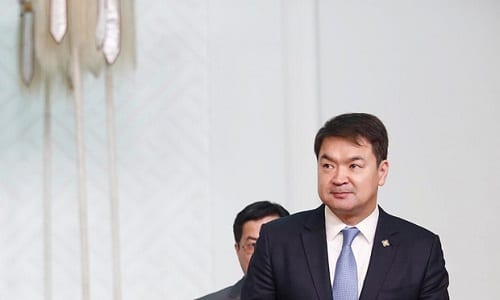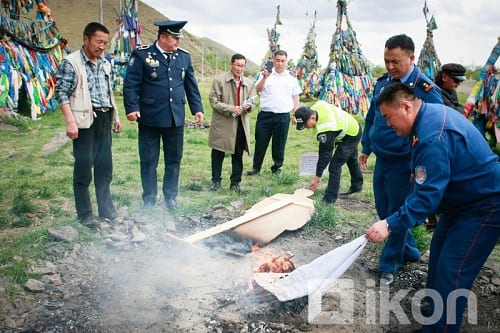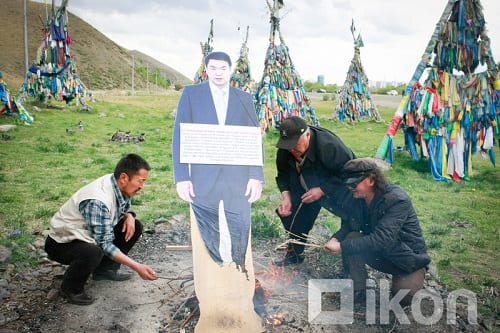Mongolia’s ‘strategic mine’ and the conflict between civil society, national government, and foreign investors
By ucsadul, on 30 June 2015
This post by Bumochir Dulam looks at recent developments in mining, civil society protest (or ‘populist protest’ as it is sometimes called in Mongolia), and the blurring of private businesses, the government or state, forms of ownership and control in Mongolia.
The State and the Mine
The 19th May, 2015 was a historic day not only for Mongolia, but also for the international community involved with developing one of the world’s largest copper deposits, Oyu Tolgoi.
After almost two years of on-going disputes, the country of Mongolia and Rio Tinto signed a $5.4 billion deal to expand the underground development of Oyu Tolgoi. The International media headlined the news, quoting Prime Minister Ch. Saikhanbileg’s statement that ‘Mongolia is [now] back to business’.

Photo excerpt from The Guardian, quoting the Prime Minister’s words, ‘Mongolia is back to business.’ Photograph: Davaanyam Delgerjargal/EPA. Source: http://www.theguardian.com
In Mongolia, the Prime Minister was careful to claim that it was not the ‘Prime Minister [who had] signed the agreement’, nor was it the state of Mongolia, but rather the representatives of the two companies. He further emphasized the importance of terminating all possible interventions by the Mongolian Government and politicians in the business of the two companies.
In many ways this announcement can be viewed as a re-declaration of Mongolia’s free market economy and the deregulation of the national economy (a practice indexing neoliberal governance elsewhere). Such a re-declaration was necessary, it can be assumed, for the national government to appeal to further foreign investors in order to prepare and secure its economy to pay over half a million USD debt, starting from 2017.
In spite of this, several mineral deposits including Oyu Tolgoi continue to be earmarked as ‘strategic’, meaning that the state has the right to claim ownership of a certain percentage of a deposit that has the potential to impact national security and national economic or social development (specifically, if the deposit has the potential to produce more than 5% of the total annual gross domestic product).
Saikhanbileg’s appeal to terminate political intervention in mining is rather mute because the nation state has special governance over strategic deposits and their wealth, which creates a situation where political interventions are unavoidable. Mongolia’s state strategizing and regulation of its major mines is a deliberate political move against the “governance of the global free market economy” (also addressed with term neoliberalism) that restricts control of the national government.
Civil Society Protests
After signing the underground development phase of Oyu Tolgoi, several civil society protesters expressed their dissatisfaction in an extremely unique way. After a press conference expressing their resistance, on the 10th June, several civil society movements, namely National Centre for Disaster (Gamshgiin Esreg Undesnii Tov) and Fire Nation Association (Gal Undesten Holboo) performed a ‘spiritual cleansing and/or punishment’ (zoligt gargah) of the Prime Minister by setting fire to his effigy and a poster listing ‘the of crimes of Ch. Saikhanbileg’, at the historic shamanic site below Bogd Khan Mountain in Ulaanbaatar.
The original connotation of this traditional ritual, prevalent in both Buddhist and shamanist traditions, is to cleanses a person of their bad deeds and prevent demonic enemy threatens. However, the current ritual organized by the protestors expressed punishment more than cleansing. To my knowledge it has never been performed against state officials, who are traditionally viewed as the ‘carriers of the State’, a semi-sacred entity in itself.
During the protest, the Prime Minister was accused of being a traitor, someone serving foreigners rather than serving the country. In a video of the event published on news websites, a woman in ordinary clothing can be seen reciting a text explaining the reasons and purpose for performing the ritual in a shamanic sacred site with dozens of wooden poles and trees covered with khadag (blue silk scarves), ovoos (stone cairns), and ancient rock paintings on a high cliff. The protest is interrupted by police officers and representatives of the General Department of Emergency of Mongolian Government, asking them to stop the fire in the ‘national park’ zone. For many, this form of political protest was seen as unusual due to its shamanic curse-like undertones.

Arrival of police officers and rangers to halt burning in protected national park zone. Source: http://www.ikon.mn/p/hki
While the concept of ‘strategic mines’, declaring the control of the state over natural resources, serves to secure the national security of Mongolia. For many foreign investors’ this is seen to be an unsustainable position for Mongolia to hold onto on an international stage, leading them to question the extent of Mongolia’s free market economy and giving rise to Imperial accusations such as ‘resource nationalism’.
From the other perspective, many civil society movements view the ‘policy of strategic mines’ as something that simply serves the ‘foreign investors’ (gadaadyn khorongo oruulagchid) and does nothing to protect the nation. They criticize the government’s dealing with foreign investors, for inflicting enormous damage on the environment and cultural heritage, for not securing enough shares for the nation, charging insufficient percentage of tax and royalty, and many express anxieties of ‘colonialism’ exercised through the global economy and transnational investors.
8 Responses to “Mongolia’s ‘strategic mine’ and the conflict between civil society, national government, and foreign investors”
- 1
-
2
White Tower, Yellow Dog: Kheviin Boov as the Centerpiece of Exchange and Transformation – 2018 Tsagaan Sar Gift Index | UCL Emerging Subjects Blog wrote on 1 March 2018:

[…] action to align with stateness (tur) is demonstrated in posts on the Emerging Subjects blog by D. Bumochir (on ritual ‘punishment’ of politicians for mishandling mining agreements), Kh. Uyanga […]
- 3
-
4
metroshoes wrote on 3 April 2023:
Elevate your style with our stunning collection of high heels shoes! From classic pumps to trendy block heels, we have the perfect pair to take your look to new heights. Our high heels are not only fashionable but also designed with comfort in mind, so you can dance the night away without sacrificing style. Browse our collection now to find the perfect pair of high heels for any occasion.
-
5
toto365pro wrote on 27 April 2023:
If you want the best content like me just go
Thank you for visiting this website every day because this website provides quality content 토토 -
6
sportstototvcom wrote on 27 April 2023:
It’s always helpful to read through content from
other authors and practice something from other sites. 토토 -
7
betmantotoorg wrote on 27 April 2023:
nice post. You’ll learn something completely new and rewarding on the sites you come across every day. 스포츠토토
-
8
slotmachinesitecom wrote on 27 April 2023:
Your way of explaining everything in this paragraph is actually great.
All easy to know it, thank you very much. 바다이야기
 Close
Close





[…] Mongolia’s ‘strategic mine’ and the conflict between civil society, national government, and f… […]